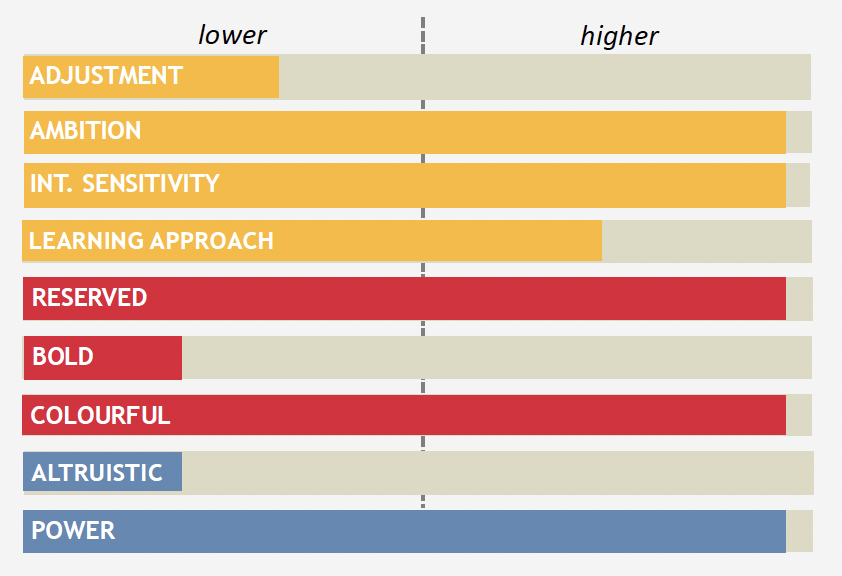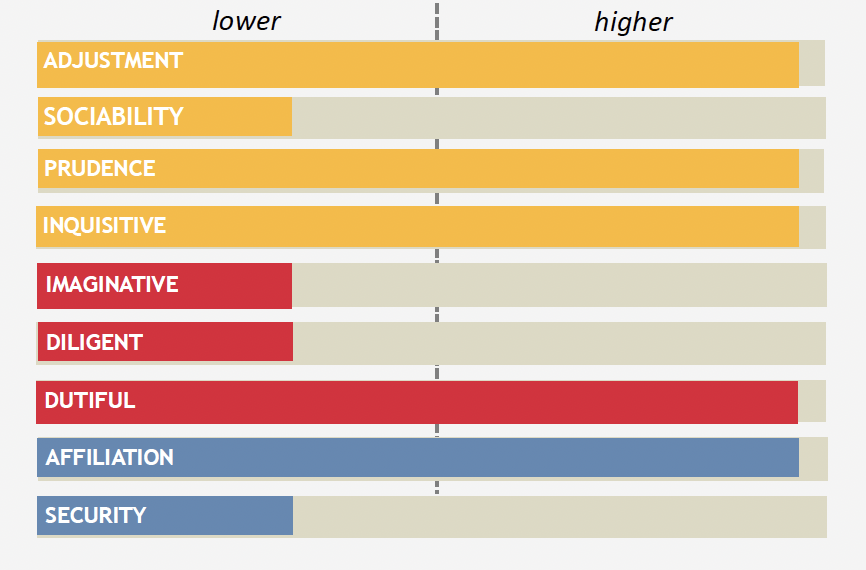Ever seen a Hogan report that made you think, ‘wait… what?’
You’re not alone. Unexpected combinations happen and understanding them is key to using Hogan effectively.
When providing interpretation and feedback, it’s important not to categorise or “correct” contradictions in the data. Instead, embrace the richness and complexity of the results:
- Normalise ambiguity: Complexity is a strength. We won’t always have all the answers. Be comfortable sitting with uncertainty, especially when profiles seem contradictory or unclear.
- Start with hypotheses, not conclusions: Use the profile to explore potential patterns and be open to shifting direction as new insights emerge.
- Integrate broadly: Draw on results across all three instruments and all relevant scales to build a fuller picture. Integrate with any real-life examples that are shared, as appropriate.
- Contextualise, don’t isolate: Don’t focus on a single score in isolation. Use related data from other scales or subscales to provide context and help resolve apparent contradictions.
- Prioritise the conversation: The psychometrics offer a valuable framework, but it’s the conversation that brings clarity, insight, and personal relevance.
- Use open-ended questions to keep dialogue exploratory. Be ready to reframe your language or pivot based on how the individual responds. Always give them space to describe their behaviour in their own terms.
Context is also key, during the conversation be sure to explore how their behaviours manifest in:
- High-pressure environments
- New or uncertain roles
- Situations outside their expertise
Discovery questions: Tools for deepening insight
Here are some discovery questions you can use to explore contradictions and unlock the power of unique combinations:
To explore variation across contexts:
- ‘When might you find each of these behaviours emerging?’
- ‘Can you think of a situation where this particular trait really helped, or hindered, you?’
- ‘Which parts of your profile feel most natural, and which feel more situational?’
To explore dominance and balance:
- ‘Is there one aspect that tends to take the lead in certain scenarios?’
- ‘How do you manage when two parts of you pull in different directions?’
To explore strengths of unique combinations:
- ‘How do you use this blend to your advantage?’
- ‘How might this combination make your approach distinct?’
- ‘Could this duality be part of your personal brand?’
To explore tensions or inhibitors:
- ‘Does one trait ever limit the expression of another?’
- ‘When has that tension been helpful, or challenging, for you?’
The goal is not to resolve every contradiction but to empower the individual to reflect, own, and work with the nuances in their profile.
Case study one: The anxious overachiever with contrasting traits

This profile featured high ambition and low adjustment – a classic ‘anxious overachiever.’ Driven and goal-oriented, this person also operated with a fair degree of anxious energy.
Conflicting combinations
High Ambition + Low Bold
While confident in areas of expertise, they became more risk-averse and hesitant in unfamiliar settings – particularly when they couldn’t self-regulate. Their confidence was experience-based, not exploratory.
High Interpersonal Sensitivity + High Reserved
This individual showed care and perceptiveness but was reluctant to share personal details. Support was reactive rather than proactive, limited to a close circle of trust.
High Interpersonal Sensitivity + Low Altruism
Helpful to their immediate team but with limited concern for broader organisational justice. This reflects the difference between style (interpersonal sensitivity) and value orientation (altruism).
High Colourful + High Reserved
On the surface, this seems contradictory. But context revealed different triggers:
- The reserved tendency dominated when stress levels were low, they’d retreat or avoid meetings.
- The colourful behaviour emerged under stress, manifesting as overly elaborate speech and a struggle to be succinct.
This shows that not all contradictions reflect inconsistency – they often highlight behavioural shifts in different psychological states.
Case study two: The strategic operator with structured delivery

This second profile showcased someone with high adjustment, calm and stress-resilient, yet again containing nuanced contradictions.
Interesting combinations include:
High Prudence + High Inquisitive
A strong thinker who combined big-picture curiosity (inquisitive) with structured delivery (prudence). Strategic yet grounded.
High Prudence + Low Diligence
A somewhat common contradiction. High prudence reflects structured thinking and rule-following. Low diligence, however, suggests less focus on meticulous execution. In practice, this person had high standards and structure but could be impatient with detail or perfectionism.
High Inquisitive + Low Imaginative
A big-picture thinker who excels at asking insightful questions and driving strategic thinking but doesn’t see themselves as particularly creative. While not a natural idea-generator, they bring real value by testing and refining others’ creative contributions. Their curiosity shows up in thoughtful, practical questions like “What does this mean?”, “What’s the plan?”, and “How do we execute?”, helping translate broad concepts into clear actions. This profile highlights the difference between being inquisitive (broad, conceptual thinking) and imaginative (creative idea generation).
High Affiliation + Low Sociability
This individual values deep, meaningful connections and prefers one-on-one interactions over group settings. While driven by a strong need for connection, they tend to avoid surface-level or broad social engagement, building narrow but high-quality networks. Often perceived as reserved or closed off outside their immediate team, they’re working on being more intentional about expanding their network. Their energy comes from genuine, in-depth relationships, reflecting a preference for depth over breadth in their social interactions.
Final thoughts
We know it can feel uncomfortable stepping into a session without having all the answers upfront – but that’s where the real value of using Hogan lies. Unlike some other tools, it allows us to embrace a degree of uncertainty and lean into the natural flow of the conversation. It’s in that space that the most meaningful insights often emerge.
Key takeaways for feedback practitioners:
- Use the tools as frameworks, not scripts.
- Prioritise open questions over neat conclusions.
- Be ready to pivot language based on client response.
- Contextualise behaviours under different conditions (e.g., stress, transition, unfamiliarity).
- Lean into ambiguity – this is often where the richest insights emerge.
Watch the full Hogan Power Hour “Making sense of unexpected combinations in Hogan reports” by joining our Hogan Power Hour LinkedIn group. You can also subscribe for future Hogan Power Hour updates via our Hogan Power Hour mailing list.